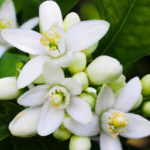Neroli. The very name evokes something ethereal, something delicate. But what olfactory reality does this intriguing moniker conceal? Neroli, extracted from the blossoms of the bitter orange tree (Citrus aurantium), presents a scent profile that’s anything but simple. It’s a complex tapestry woven with threads of citrus, floral sweetness, and an undercurrent of intriguing bitterness, making it a prized ingredient in perfumery.
The Initial Encounter: A Burst of Sunshine
The initial impression of neroli is often described as a bright, zesty citrus. Imagine the first rays of dawn breaking through a grove of orange trees, laden with dew. That’s the immediate sensation. Unlike the sharp, acidic tang of lemon or grapefruit, neroli’s citrus aspect is softer, more rounded, and possesses an almost effervescent quality. This isn’t the blunt force of a citrus rind; it’s the gentle caress of sun-ripened fruit.
This sun-kissed opening is crucial to neroli’s appeal. It provides an uplifting and invigorating start, setting the stage for the more nuanced layers to follow. Think of it as the overture to a complex symphony, a promise of olfactory delights to come.
The Heart of the Matter: Floral Opulence
As the initial citrus burst mellows, the floral heart of neroli begins to unfold. This is where the true character of the scent emerges. Neroli possesses a unique floral sweetness, distinct from the heady, intoxicating aroma of jasmine or the powdery elegance of iris. It’s a lighter, more airy floral, reminiscent of orange blossoms in full bloom on a warm spring day. The sweetness isn’t cloying or saccharine; instead, it’s tempered by a subtle herbaceous quality that prevents it from becoming overwhelming.
This floral heart is the soul of neroli, the essence of its captivating beauty. It’s a delicate dance of sweet and green, a harmonious blend that defines its unique character.
The Intriguing Undercurrent: A Whisper of Bitter Green
Beneath the bright citrus and delicate floral notes lies a subtle but crucial element: a whisper of bitter green. This isn’t an aggressive or off-putting bitterness; it’s a refined, almost imperceptible undertone that adds depth and complexity to the overall scent. It’s reminiscent of the green leaves and twigs of the bitter orange tree, providing a grounding counterpoint to the sweetness of the blossoms.
This subtle bitterness is what separates neroli from other floral fragrances. It prevents it from becoming overly sweet or simplistic, adding a layer of sophistication and intrigue. It’s the olfactory equivalent of a minor key in a musical composition, adding a touch of melancholy that enhances the overall beauty.
The Longevity and Projection: A Delicate Trail
Neroli, being a lighter floral note, typically has moderate longevity and projection. It’s not a scent that will dominate a room, but rather one that lingers subtly, creating a delicate aura around the wearer. It’s the olfactory equivalent of a soft whisper, a fragrance that draws people in rather than pushing them away.
The projection of neroli is often described as “close to the skin,” meaning that it’s most noticeable when someone is in close proximity to the wearer. This makes it an ideal choice for those who prefer a more understated and intimate fragrance experience. It’s a scent for personal enjoyment, a subtle indulgence that doesn’t demand attention.
The Perfumeur’s Palette: Neroli’s Versatility
Neroli is a remarkably versatile ingredient in perfumery, lending itself well to a wide range of fragrance compositions. It can be used to add brightness and freshness to citrus-based perfumes, to enhance the floral heart of white floral fragrances, or to provide a touch of elegance to woody or oriental scents. It’s a true olfactory chameleon, adapting to its surroundings while still retaining its unique character.
It complements other citrus notes like bergamot and mandarin, as well as floral notes such as jasmine, rose, and tuberose. Its subtle bitterness also allows it to pair well with woody notes like sandalwood and cedarwood, creating intriguing contrasts. Perfumers often use neroli to “lift” heavier fragrances, adding a touch of lightness and airiness.
Beyond the Scent: The Psychological Impact
The scent of neroli is often associated with feelings of happiness, relaxation, and well-being. Its bright citrus notes are uplifting and invigorating, while its delicate floral sweetness is calming and soothing. It’s a fragrance that can evoke feelings of nostalgia, reminding us of warm summer days and blooming orange groves. Aromatherapists often use neroli essential oil to reduce stress and anxiety, promoting a sense of inner peace and tranquility.
This psychological impact is a significant part of neroli’s appeal. It’s not just a pleasant scent; it’s a mood enhancer, a subtle way to improve one’s overall sense of well-being. It’s the olfactory equivalent of sunshine on a cloudy day, a reminder that beauty and joy can be found even in the simplest of things.
A Final Olfactory Portrait
In conclusion, the scent of neroli is a complex and captivating blend of bright citrus, delicate floral sweetness, and a subtle undercurrent of bitter green. It’s a versatile ingredient in perfumery, lending itself well to a wide range of fragrance compositions. More than just a pleasant aroma, neroli offers a sense of well-being and tranquility. It’s a fragrance that whispers rather than shouts, leaving a lasting impression of elegance and sophistication. It is an olfactory elixir that captures the very essence of the Mediterranean sun.







Leave a Comment